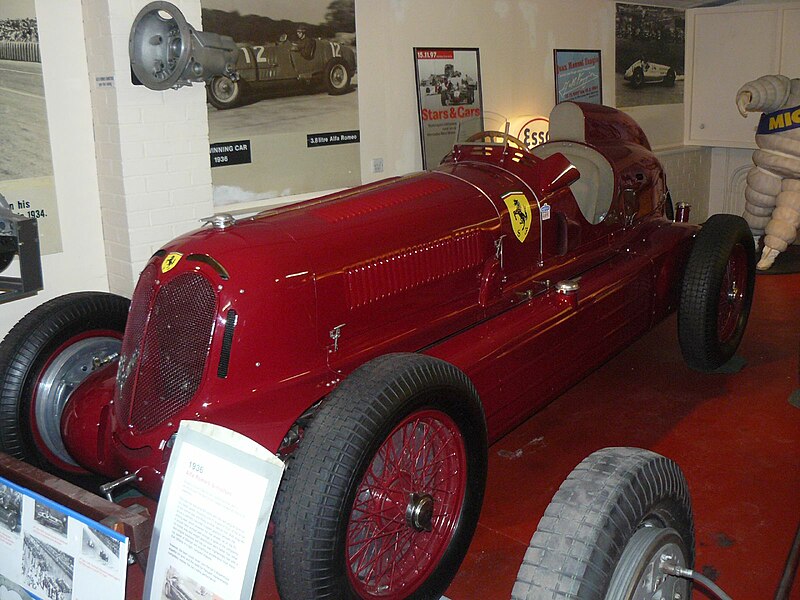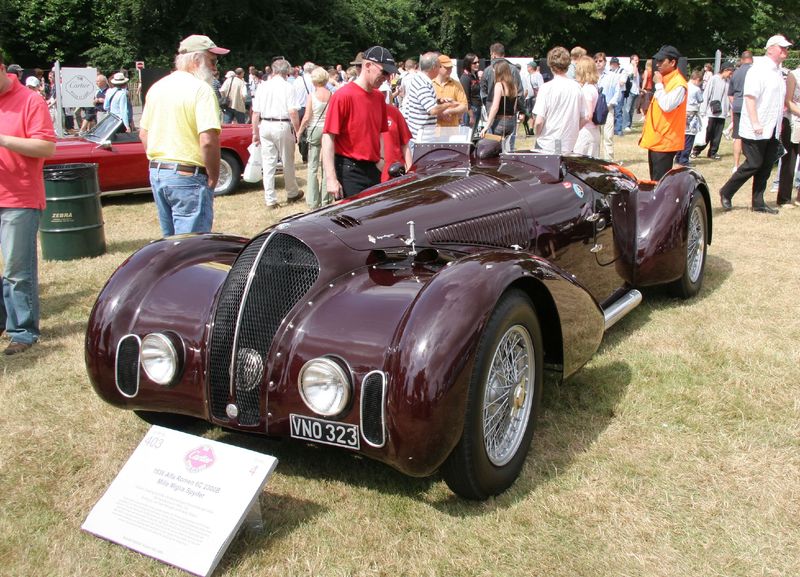1931 Tipo A
Alfa Romeo Tipo A Monoposto was the first monoposto (single-seater) racing car, designed by Alfa Romeo. The car had two 6C 1750 straight-6 engines and gearboxes assembled side by side. Producing 230 bhp (172 kW), the car had top speed of 149 mph (240 km/h).
The car's best racing achievement was in the Coppa Acerbo of 1931; Tazio Nuvolari was third with Giuseppe Campari winning. Luigi Arcangeli was killed at Monza in 1931 while practising with this car for the Italian GP. The car's complex design ultimately led to it being very unreliable; Jano started to design a new car, the Tipo B (P3), to fix this problem. The Tipo A was made only four examples and only one replica exist today in Alfa Romeo Historical Museum in Arese.
1931 8C 2300 Monza
1932 Tipo B (P3)
The Alfa Romeo P3, P3 monoposto or Tipo B was a classic Grand Prix car designed by Vittorio Jano, one of the Alfa Romeo 8C models. The P3 was first genuine single-seat Grand Prix racing car and Alfa Romeo's second monoposto after Tipo A monoposto (1931). It was based on the earlier successful Alfa Romeo P2. Taking lessons learned from that car, Jano went back to the drawing board to design a car that could last longer race distances. The P3 was the first genuine single seater racing car, and was powered by a supercharged eight-cylinder engine. The car was very light for the period, weighing just over 1,500 lb (680 kg) despite using a cast iron engine block.
1935 Bimotore
In 1935, to compete with Mercedes Benz and Auto Union, Enzo Ferrari (Race team manager) and Luigi Bazzi (Designer) built a racer with two 3.2 (3.165-litre) engines, one in the front and one in the rear, giving 6.3 litres and 540 bhp (403 kW). The drivetrain layout was unusual. The two engines were connected by separate driveshaft to a gearbox with two input shafts, and two angled output shafts, so each of the rear wheels had its own driveshaft. It could never quite succeed against the Mercedes W25 B of Rudolf Caracciola, and was hard on fuel and tyres. The gain in speed was offset by increased pit times. On May 12, 1935, two were entered in the Tripoli Grand Prix driven by Nuvolari and Chiron who finished fourth and fifth. Chiron managed a second at the following 1935 Avus race.
1935 8C 35
1935 8C 2900A
1936 12C 36
The Alfa Romeo 12C or Tipo C was a 12-cylinder Grand Prix car. The 12C-36 made its debut in Tripoli Grand Prix 1936, and the 12C-37 in Coppa Acerbo 1937. The 12C-36 was a Tipo C fitted with the new V12 instead of the 3.8 litre straight-eight of the 8C-35. The 12C-37 was a new car, with a lower chassis and an engine bored and stroked to 4475 cc, now with roller- instead of plain bearings and two smaller superchargers instead of a single large one. The car suffered poor handling, which could not be cured in time for the 1937 Italian GP, and thus was not successful. This is given as the reason for Vittorio Jano's resignation from Alfa Romeo at the end of 1937. The 12C-36 used the existing six Tipo C chassis. Four examples of the 12C-37 were built, although only two were actually assembled for the 1937 Coppa Acerbo and Italian GP. Early in 1938, the Tipo C (8C-35, 12C-36) chassis were modified into 308s, with the straight-eight engine fitted lower in the chassis and a completely new body. The four 12C-37 chassis were instead assembled into 312 (V12 downsized to 3-litre) and 316 (V16 obtained from two 158 engines fitted to a common crankcase) formula race cars.
1937 12C 37
1937 6C 2300B Mille Miglia
1937 8C 2900B Mille Miglia
1938 308
The Alfa Romeo 308 or 8C-308 is a Grand Prix racing car made for the 3 litre class in 1938, only four cars were produced, actually modified from Tipo C with the engine mounted lower into the chassis and a slimmer body. The chassis was derived from the Tipo C and the engine from the 8C 2900. The 308 was engineered by Gioacchino Colombo under the control of Enzo Ferrari who was then in charge of Alfa's racing team, Alfa Corse. The car debuted at the Pau Grand Prix in 1938, where two cars were entered to race, one for Tazio Nuvolari and the other for Luigi Villoresi. Both drivers had to withdraw from competition, however Nuvolari had by then set a lap record. The next race was the Tripoli Grand Prix. The new 312 (3-litre, 12 cylinders) and 316 (3-litre, 16 cylinders) were entered, but they had engine trouble during practice and Clemente Biondetti took the start at the wheel of the 308 held in reserve. He failed to finish, while Hermann Lang, driving a Mercedes-Benz W154, was the winner. In this race, Eugenio Siena, driving a 312, was killed after hitting a wall.
1938 312
Tipo 312 was one of three Alfa Romeo cars designed for the new rules in 1938, which differed mainly by the engine; the other two cars were the Alfa Romeo Tipo 308 with straight-8 engine and Alfa Romeo Tipo 316 with a V16 engine. The car was based on unsuccessful Alfa Romeo 12C-37; it was made easier to control than its predecessor. The engine in 312 is 3-litre 60° V-12 with roots supercharger; it was more powerful than 308 but it was still not really competitive with German rivals.
1938 316
Alfa Romeo Tipo 316, 316 or 16C-316 Grand prix car was used in Grand Prix seasons 1938 and 1939, when it was driven by Giuseppe Farina and Clemente Biondetti. The Tipo 316 was one of three Alfa Romeo cars designed for the new rules in 1938, which differed mainly by the engine, the other two were the Alfa Romeo Tipo 308 straight-8 and Alfa Romeo Tipo 312 with a V12 engine. The car was based on Alfa Romeo 12C-37. It had roots supercharged 60 degree V16 engine producing about 350 brake horsepower (260 kW) at 7500 rpm. The engine was more powerful than the one in Tipo 308 or 312, but it was still not really competitive against Germans.
1938 158
The Alfa Romeo 158/159, also known as the Alfetta (Little Alfa in Italian), is one of the most successful racing cars ever produced. The 158 and its derivative, the 159, took 47 wins from 54 Grands Prix entered. It was originally developed for the pre-World War II voiturette formula (1937) and has a 1.5-litre straight-8 supercharged engine. Following World War II, the car was eligible for the new Formula One introduced in 1947. In the hands of drivers such as Nino Farina, Juan-Manuel Fangio and Luigi Fagioli, it dominated the first two seasons of the World Championship of Drivers.
1939 6C 2500 Super Sport Corsa












.jpg/800px-Alfa-Romeo-159-(1951).jpg)






.jfif)


No comments:
Post a Comment